The main indicators of a healthy body are cleanliness and smoothness of the skin. Defects on it indicate the presence of unhealthy processes in the body.
Pustular acne is one of the types of skin lesions that are included in a number of inflammatory diseases. Excessive secretion of the sebaceous glands is the main cause of inflammation.
The process of formation of ulcers
The fat that the sebaceous gland produces in excess amounts clogs the sebaceous ducts. The result is a painful, purulent pimple. Most often this occurs in the chest area, on the head, face, back, buttocks and intimate areas, in places where profuse sweating occurs. Negligent treatment of skin rashes leads to aggravation of the inflammatory process, which is why scars and cicatrices remain on the skin.
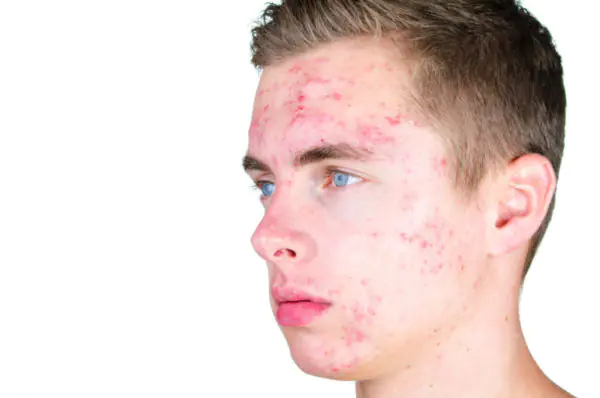
The appearance of purulent acne in the face area
The face is the most common area where ulcers are affected. First, a small bump appears on the skin with reddened skin around it. The inflamed area begins to ripen, hurt and itch, increasing in size. The abscess becomes more noticeable. The focus of its inflammation is called a core neoplasm with a yellow-white tint.
Attention! Abscesses on the face are one of the indicators of a teenager entering adolescence, when the body matures, accompanied by a hormonal surge, so during this period you should carefully care for the surface of the skin.
Why does a pustular pimple appear?

There are several factors that contribute to the appearance of acne:
- Disturbed hormonal balance. The period of menopause, pregnancy or menopause is characterized by changes in hormonal levels, so purulent acne in women appears in the face, neck, chest or back.
- Unhealthy food. Diseases of the gastrointestinal tract, liver, alcohol abuse, and fatty foods are the result of poor nutrition. As a result, metabolic processes are disrupted.
- Transitional age. Acne is typical for adolescents during puberty, when hormonal imbalances are a consequence of changes in the body. Hormones become hyperactive, changing the body of girls and boys.
- Development of hyperkeratosis. This is the rapid division of skin cells, so they quickly become horny and flake, clogging the pores. The accumulation of subcutaneous fat in these places leads to the appearance of purulent bacteria. Hyperkeratosis is a pathological process due to impaired blood supply, as well as a lack of vitamins in the body.
- Consequences of improper extrusion. Dermatologists and cosmetologists do not advise squeezing out purulent pimples on your own, citing the possibility of worsening the inflammatory process, after which scars remain on the skin.
- Stressful situations. Stress reduces the body's protective functions, so its resistance to the effects of bacteria with frequent nervous breakdowns and depression is significantly reduced.
- Poor quality cosmetics. Cosmetics that do not suit the skin and are expired are an excellent provocateur for the occurrence of ulcers.
- Steroid drugs or antibiotics.
- Lack of proper skin care. Insufficient cleansing of the skin or neglect of existing ulcers.
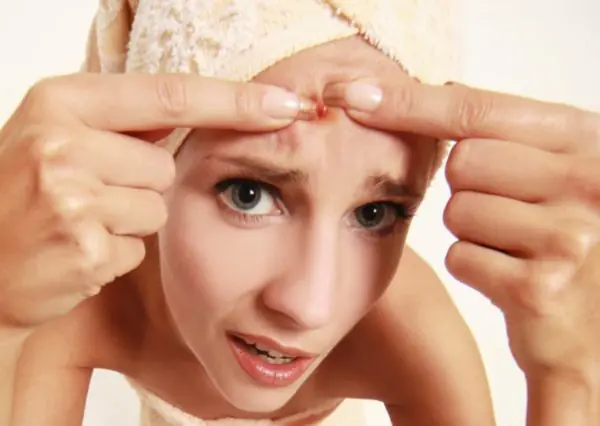
Types of purulent acne
A papule is an infected acne pimple, which is characterized by painful sensations and the presence of a small reddish bump. Pus is not visible to the naked eye. Scars do not remain after they disappear.
Important! If papules appear multiple times, you should consult a doctor, as this may be evidence of the development of horny eczema, amyloidosis, psoriasis, syphilis and other diseases in the body.
A pustule is a severe form of papule. It looks like a rounded-superficial or deep tubercle filled with pus. A deep pustule forms an ulcer, which eventually becomes covered with a crust. After it falls off, a scar remains at the site of the pimple. The skin around the lesion is inflamed, which is why it is red. The form of pustules is:
- hemispherical;
- cone-shaped;
- flat;
- spherical.
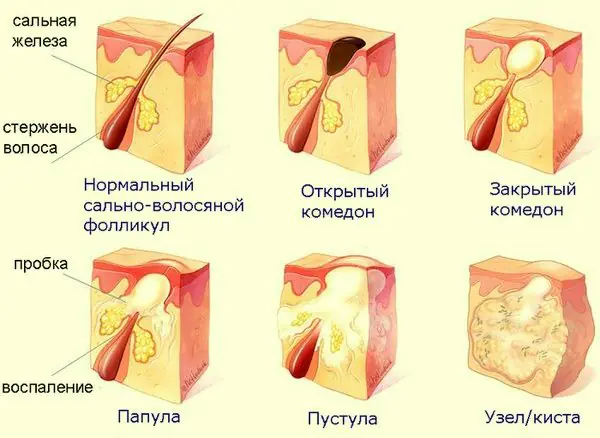
A follicular abscess of staphylococcal nature affects the hair column and is of streptococcal nature.
- A nodule is a papule, the size of which exceeds one centimeter. The deep layer of the skin is affected, so the pain is pronounced. A healed nodule leaves a pigment spot, atrophic or keloid scar of a large size.
- Cyst - formed in a severe form of purulent pimple, which consists of several blackheads filled with pus and processed sebum. The cysts form a chain connected by the fistula duct. A cystic conglomerate is characterized by a bluish tint, is difficult to treat, and also leaves deep scars on the skin when healing.
Degree of disease with purulent acne
- Small comedones, smoothly turning into papules (rarely into pustules), covering small areas of the skin.
- Increased area of rashes compared to the first degree.
- A large number of pronounced pustules, papules and comedones. The skin is itchy. Healed purulent formations leave marks.
- Stage requiring medical treatment. Bluish bumps, the size of which exceeds five millimeters. After healing, scars and scars remain.
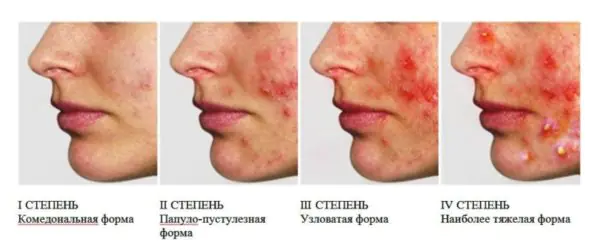
Treatment
Removing acne on your own can lead to inflammation rather than cure it. Treatment of ulcers requires an integrated approach.
It is recommended to begin therapy by getting rid of the purulent rash. Then the root causes are eliminated, and the body’s metabolic processes are normalized.
The first rule is to contact a specialist in a timely manner. Modern treatment methods in beauty salons make it possible to do this.
Treatment options
- Liquid nitrogen – freezing of pustular rashes, their destruction. Cryotherapy is the basis of this method.
- Distilled water – ozone therapy technology.
- Ultrasound – deep cleaning and removal of dead cells.
- Chemical peeling – allows you to remove dead skin cells.
- Mechanical cleansing is preventive skin care.
- Mesotherapy allows you to individually select effective medications for each skin type, taking into account the degree of progression of the disease.
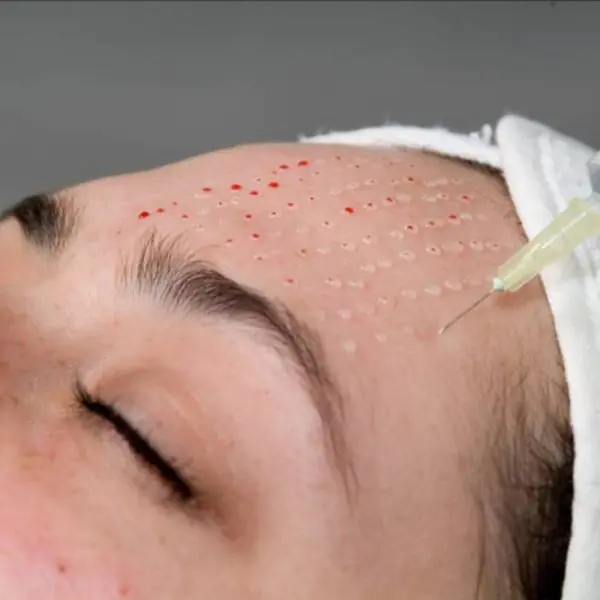
Traditional medicine in the treatment of pustular acne
In order to cure this disease, there are many recipes from natural plants. These are decoctions, ointments and other compositions prepared mainly for cleansing and restoring the skin.
The properties of the plant are used to heal the surface of the skin. The treatment is characterized by simplicity, ease and relative cheapness.
Remove all needles from one aloe leaf and cut it in half. The resulting pulp is applied to the purulent wound and secured with a plaster. The procedure is carried out before bedtime, in the evening.
Advice! It is recommended to use a bactericidal patch. An open wound increases the possibility of infection. Its drainage effect will help remove the purulent contents of the wound.
Medicines
If there are reasons that do not allow you to use traditional medicine, you can use medical ointments:
- ichthyol ointment;
- Vishnevsky ointment.
These drugs have an antiseptic effect, kill the carrier of the infection, and remove the purulent contents of the pimple out. In addition, after cleansing the wound, it heals faster, since the action of the ointments promotes the regeneration of the dermis. Before each application of a fresh layer of ointment, the affected area should be cleaned.
Important! The use of medications or folk remedies to cleanse the skin significantly accelerates the healing process of purulent wounds, and timely preventive skin care completely eliminates relapses of inflammatory processes.
Purulent acne on the face can appear in different areas and can ruin any appearance. It is almost impossible to disguise them with cosmetics. In addition, such rashes are often accompanied by painful sensations, swelling and swelling. Curing acne is not so easy, it will take a long time.
Reasons for appearance
Possible causes and treatment are closely related, so it is initially necessary to find out why purulent pimples appear on the face and what factors influence their formation. This phenomenon is observed due to the following deviations:
- Hormonal imbalance. Most often, the appearance of acne is observed during puberty, when restructuring begins in the body, which leads to the active work of the sebaceous glands. Also, a hormonal surge occurs during pregnancy and menstruation. If purulent pimples appear on the face, the reasons for their formation may lie in incorrectly selected hormonal drugs or birth control pills.
- Insufficient facial skin hygiene. Improper care or lack thereof leads to the proliferation of bacterial organisms on the surface of the epidermis. They not only provoke purulent rashes, but also contribute to the development of various skin diseases.
- Cosmetical tools. People with problem skin need to be more careful when choosing cosmetics. Many foundations clog enlarged pores, thereby worsening the condition of the skin, causing inflammation and rashes on the face.
- Poor metabolism. Regular consumption of fatty foods and insufficient exercise lead to poor metabolism. This lifestyle not only contributes to excess weight gain, but is also accompanied by the formation of pimples with pus.
- Allergy. Reactions to certain foods and environmental factors are often accompanied by irritation and rash.
- 6. Diseases of internal organs. The causes of purulent acne may be associated with various pathologies in the functioning of organs. In this case, it is possible to cure inflammation if the underlying problem is eliminated.
- Avitaminosis. A lack of vitamins has a bad effect on the skin, making it dull. In addition, natural protection against the penetration of pathogenic microorganisms is reduced.
- State of stress. Deviations in the functioning of the nervous system lead to a decrease in immunity and the body’s ability to resist bacterial attack. Purulent acne on the face is a consequence of this phenomenon.
Regular cleansing of the skin prevents acne in many cases. There is no need to neglect it, even if another factor is considered the primary source of acne. In particular, do not forget about removing makeup before going to bed.
Acne classification
Rashes differ in appearance and location on the skin. In addition, each type has its own causes. There are the following types of acne:
- Purulent acne, blackheads and enlarged pores are formed due to poor skin cleansing. They are observed in the T-zone, since this area contains the largest number of sebaceous glands.
- Red purulent pimples on the face are hormonal in nature. In this case, they can be found on the forehead and chin.
If comedones are infectious in nature, then such pimples are called papules. They look like small pinkish balls, without a head. In advanced cases, they settle deep under the skin and acquire a scarlet tint. Classified as nodes.
If the red pimples are itchy, then there is a possibility that this phenomenon is the result of an allergic reaction.
- White, purulent pimples or pustules (photo below) may appear due to excessive accumulation of sebum. They are formed due to digestive system failures, teenage changes, and poor skin cleansing. Most often they are large in size with a white head. To cure a large purulent pimple, you need a systematic approach, consisting of proper care, nutrition, and health care.
Treatment
There are several methods to combat purulent acne: medication, cosmetic treatment and home therapy. In many cases, special preparation of the skin is necessary before treating the rash. It is steamed by holding your face over a hot bath for some time. As a result, the pores open, cleansing occurs more effectively, and the applied medications penetrate and are absorbed well.
Medication
A large selection of ointments, gels and creams makes it possible to choose the most suitable product. The following products are especially popular.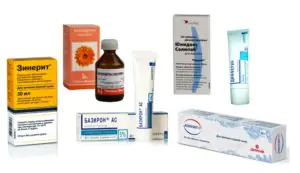
- Baziron AS, characteristics:
- destroys microbial organisms, preventing them from multiplying and spreading;
- applied to previously cleansed skin;
- the pustular rash on the face will disappear if you rub the drug twice a day;
- contraindications include pregnancy, lactation and age under 12 years;
- may cause dryness and flaking.
- Skinoren, characteristics:
- is prescribed if the ulcers on the face have already spread and are in an advanced state;
- Apply the gel to the affected areas using massaging movements;
- the rash goes away in about a month;
- During the action of the drug, burning and itching may be felt.
- Ichthyol ointment, characteristic:
- has a powerful antimicrobial effect;
- relieves irritation and inflammation;
- relieves pain;
- stimulates blood circulation, thereby triggering the delivery of oxygen to the affected tissues;
- purulent acne located deep under the skin can be treated. Then the medicine is applied overnight to draw out the contents.
- Zenerite, characteristics:
- treats white pustules on the face;
- has a wide spectrum of action, so it easily destroys different types of bacteria;
- regenerates damaged areas in a short time, controls sebum production;
- allowed during pregnancy and lactation;
- There are side effects in the form of redness and irritation.
- Vishnevsky ointment, characteristics:
- used to solve many problems associated with inflammation;
- the principle of action is to warm the affected area, thereby provoking the maturation of the pimple and the removal of its contents;
- has a natural composition and a specific smell;
- You can apply it for several hours, or make a compress for the whole night.
How to remove a purulent pimple on the face if these products have not yet been purchased, but you need to look flawless? In this case, an aspirin tablet, which is probably present in every first aid kit, will help. It is pounded, a little water is added, then the pulp is spread on the problem area. The active substances included in the drug destroy bacteria.
Cosmetology
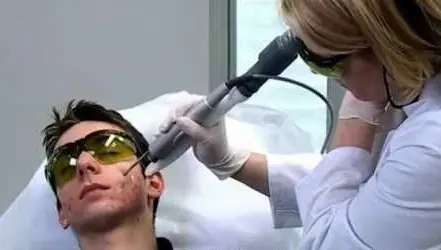
In beauty salons there are a number of procedures aimed at combating purulent rashes. Hardware cosmetology and deep cleansing have gained the most popularity. Let's present the most popular and effective of them:
- Laser therapy. With the help of heat, the sebaceous glands and pathogenic microorganisms present are affected. They are destroyed, thereby preventing inflammation and pustular rashes. To achieve maximum results, you must complete the full course.
- Phototherapy. Based on the influence of light waves on the layers of the epidermis. Bacteria are destroyed and the production of collagen and elastin is stimulated. Thanks to this procedure, pus does not form under the skin, and acne disappears.
- Peeling. It has many advantages, as this method not only treats a purulent rash on the face, but also eliminates pigment spots, scars, the effects of post-acne and other skin defects. The superficial keratinized layer of skin is also removed, making it smooth and soft.
- Cleaning. Blackheads are removed. Mechanically remove pus and impurities from the pores. In this case, the specialist uses certain cosmetic tools - a strainer and a spoon. The cleaning itself is accompanied by a number of unpleasant consequences, as the skin is injured. It is carried out no more than twice every six months. It is necessary to use a healing ointment or cream.
- Ozone therapy. If purulent pimples appear periodically on the face, ozone treatment will help cope with this problem. The substance envelops the abscess, relieving inflammation and eliminating excess sebum.
- Cryotherapy. Large purulent pimples on the face can be removed by exposure to liquid nitrogen. After such a session, they dry out in a short time and go away completely.
Folk remedies
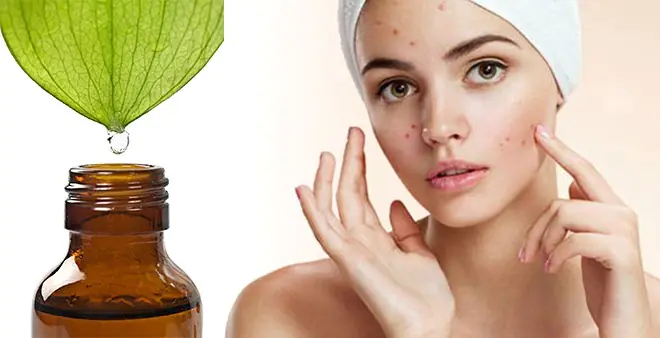
Sometimes the rash occurs so unexpectedly that there is no opportunity to visit the pharmacy, or the use of pharmaceutical drugs causes a negative reaction on sensitive skin. Therefore, many are interested in how to treat purulent acne on the face at home using only natural ingredients. Let's present a few effective recipes:
- Decoctions. This product contains herbs that have antimicrobial, soothing and healing properties. The most commonly used are St. John's wort and chamomile. These plants are mixed in equal proportions and filled with hot water. Then boil for about half an hour. There are several ways to get rid of purulent acne on the face with the resulting decoction. You can wipe your skin at least twice a day, or freeze the liquid into cubes and use it in the morning. This use has an additional tonic effect.
- Aloe. This plant is very effective in combating single rashes. If a purulent pimple appears on your nose, then you should apply a cut piece of aloe to it and fix it overnight. In the morning, the remains of the blackhead are removed with a cotton pad. The pulp of the leaves is also used to prepare lotions necessary to eliminate more extensive lesions. Fill it with a small amount of water, let it stand for an hour, then bring to a boil. The resulting infusion is used to treat rashes.
- Plantain. The most affordable and useful remedy in the summer. In order to get healing juice, you need to find a large, healthy plant with juicy, fleshy leaves. After squeezing well, wipe your face as often as possible. It has antiseptic effects and improves blood circulation.
- Oatmeal mask. Oatmeal is mixed with egg and lemon juice. Add a small amount of boiled water and let it brew until the cereal softens and swells. This mixture is applied to problem areas for 20 minutes, then washed off and a nourishing cream is used. This method has a beneficial effect on the functioning of the sebaceous glands and dries out rashes well.
- Oils. Regularly treating the face with oils not only relieves inflammation and redness, but also charges the epidermis with vitamins and helps renew its cellular structure. This method of dealing with purulent acne is only suitable for those with dry skin. Oils can be different, for example olive, peach or apricot.
Prevention
As already noted, treating purulent acne is not an easy process, so it is easier to prevent their occurrence. Proper hygiene, care, balanced nutrition and health care are the basis of clear skin. Some preventive measures will help achieve the desired result:
- it is necessary to carefully care for your facial skin;
- do not forget to wash off decorative cosmetics at night;
- if a purulent pimple appears, do not squeeze it out under any circumstances, but apply the medicine;
- consume enough vitamins with food every day, or drink vitamin complexes;
- limit your consumption of fatty and sweet foods, add more fruits (low in sugar) and vegetables to your diet;
- use high-quality cosmetics, preferably with natural ingredients;
- if the skin is prone to oiliness and pustular pimples appear periodically, it is necessary to use special means to prevent their formation and normalize the activity of the sebaceous glands;
- use medications correctly, especially hormonal ones. A doctor's supervision is necessary in this matter.
Despite the fact that many people suffer from purulent rashes, the approach to their treatment must be individual. A variety of therapeutic methods makes it possible to choose the most suitable and effective for each specific case.
Reviews
Irina 30 years old:
To get rid of purulent acne, I used different methods. The aloe mask helped the best. It is more effective than many creams and ointments. This plant can pull out even the deepest pimple.
Alena 24 years old:
Starting from adolescence, purulent acne constantly bothered me, the situation especially worsened before menstruation. I used different means, but the results did not last long. Baziron AS came to the rescue, I have been using it for several years, it is easy to apply, does not dry out the skin, and eliminates the problem in a short time.
Everyone strives for clean and beautiful facial skin, so the appearance of acne on it is always frustrating, brings embarrassment and discomfort, worsens the quality of life and leads to the development of complexes.
Particularly unpleasant are purulent formations that appear unexpectedly, always hurt, grow to large sizes and take a long time to mature.
What it is
Purulent acne (pustules) is a purulent inflammation of the hair follicle and the adjacent sebaceous or sweat gland. They appear either singly or en masse on any part of the body, but most often on the face.
Visually, edema, swelling and a small white head are visible at the site of their formation. There is a purulent core inside, which causes discomfort, itching, and pain throughout the entire development stage. Unpleasant symptoms disappear after the formation is opened and the purulent mass comes out.
Is it possible to press
Doctors also do not recommend this manipulation for the following reasons:
- You can become infected with furunculosis.
- Dirt and dust can get into the wound from unclean nails and hands, which will lead to infection of the deep layers of the skin and damage to the sebaceous glands.
- Inflammation can quickly spread to healthy areas or cause blood poisoning.
- Scars form.
Opening a pustule can only be trusted to a cosmetologist. For self-treatment, there are now a lot of products that can be freely purchased at the pharmacy.
Causes of purulent acne on the face
Usually the reason for the formation of purulent acne is skin irritation or clogging of pores with dust. But it is not only insufficient hygiene that is to blame for this.
Often, many internal and external conditions affect their appearance, even if hygiene procedures are carried out regularly and efficiently.
In men
At the age of up to 20 years, purulent rashes are provoked by hormonal activity, which is characteristic of puberty. Almost 60% of young people are susceptible to this phenomenon.
Factors that cause acne are also:
- disruption of hormone levels;
- hereditary predisposition;
- low sexual activity;
- pathologies of the digestive system;
- hyperkeratosis is a skin disease that is accompanied by thickening of the stratum corneum;
- physical weakness;
- psycho-emotional fatigue;
- long-term use of hormones (anabolic steroids) or certain medications (for example, antibiotics);
- poor nutrition, as well as violation of eating habits;
- skin irritation after shaving.
The child has
In babies under six months of age, neonatal pustulosis is considered normal and occurs in every second child. Usually pimples are located on the face and head, rarely on the neck and ears.
The exact reason for their appearance is not known. But doctors are considering 2 versions: changes in hormonal levels and adaptation of the child’s body in a new environment (anhydrous). The formations do not bother the child in any way and pass quickly.
The list of reasons why rashes appear in children under one and a half years old is expanding. These are mainly “childhood” diseases, although poor nutrition, poor hygiene and low immunity cannot be ruled out.
Conditions in which an abscess is one of the symptoms include:
- Milia – a skin disease that manifests itself due to weak functioning of the sebaceous glands.
- Diathesis - the predisposition of the child’s body to manifest a pathological reaction to an external stimulus or is a harbinger of a certain disease.
- Intertrigo - a skin disease that occurs when the skin is regularly exposed to a damp environment.
In children of kindergarten and primary school age, the rash appears due to:
- insufficient hygiene;
- microtraumas;
- poor nutrition;
- digestive problems.
Among women
The formation of pustules is explained:
- Wrong choice of caring and decorative cosmetics or their low quality.
- Hormonal changes in adolescence, before menstruation, during pregnancy and breastfeeding, and entering menopause.
- Skin infection.
Timely adoption of measures to eliminate many of these causes will help reduce the likelihood of the formation of purulent acne.
Prevention
Doctors never cease to repeat that the best way to prevent disease is prevention. This also applies to the appearance of ulcers on the face.
To prevent their occurrence, you must adhere to the following rules:
- Do not use expired cosmetics.
- Maintain cleanliness and promptly change sponges, powder, and brushes.
- Remove all makeup at night.
- Do not squeeze pimples yourself.
- Adjust your diet by eliminating or reducing “harmful” foods.
- Use antibacterial skin care products regularly.
- Lead an active and healthy lifestyle.
How to use acne gel on face? More details here.
How to treat
Treatment of ulcers involves an integrated approach to the problem, and in addition to eliminating the external manifestation, it implies getting rid of the cause that caused their appearance.
Medication
The choice of medications is extensive, and without the help of a doctor you can get lost in their range. All funds are selected individually. Also, a treatment regimen is developed for each patient, depending on the causative factor.
External means
Vishnevsky ointment
Has strong healing and regenerating effects. The principle of its action is to warm the abscess and skin area, which accelerates the breakout of the pimple and draws out pus from the wound.
Used according to the scheme:
- Fold sterile gauze into 4 layers.
- Apply a little ointment to it.
- Apply a compress to the problem area.
- Cover the top with polyethylene and secure with adhesive tape.
The ointment is also used to prevent the formation of pustules: you need to lubricate the area that is bothered by pain and itching, and after 30-40 minutes. wash off. The product is not recommended for use with highly sensitive skin.
Video: Vishnevsky ointment - all about the drug
Baziron AS
The gel stops the proliferation of bacteria and pathogenic microorganisms, thereby eliminating the main cause of acne.
The application rules are the same as the previous product with the only difference that “Baziron AS” is applied with massage movements 2 times a day: in the morning and at night.
In addition to the above mentioned remedies, you can use ichthyol, syntomycin and salicylic ointments to eliminate ulcers. Metrogyl, Levomekol, Zinerit, Skinoren-gel dry and heal the wound well.
Domestic
The following medications are prescribed for internal use:
- Antibiotics: Erythromycin, Levomycetin, Metronidazole.
- Hormones in birth control pills: “Yarina”, “Jess”.
- Retinoids: Roaccutane, Retinol Palmitate.
- Probiotics: “Lactofiltrum”, Linex.”
- Vitamin and mineral complexes.
The results of using each remedy are individual and depend on the cause, characteristics of the body, immunity, and also on the severity of the condition.
Folk remedies
In alternative medicine, there are recipes that help eliminate purulent acne on the face. But their use is possible only after consultation with a doctor and his approval.
Well proven:
- St. John's wort. Prepare a decoction: 2 tbsp. l. pour the flowers of the plant with 2 tbsp. water, simmer over low heat for 15-20 minutes. After cooling, strain and wipe the skin twice a day.
- Sagebrush. To prepare the infusion 2 tbsp. l. 500 ml of dried plant is poured. boiling water, infuse for 8-9 hours. Afterwards, the product is filtered and used as directed 4 times a day.
- Plantain. The juice of the plant is a strong antiseptic and has an effect on wound healing. It can be used to treat both the inflamed area and the entire face for preventive purposes 4-6 times a day.
To combat purulent formations, you can also take mustard powder, iodine, tar soap, chamomile, oatmeal with lemon juice, calendula, aloe, etc.
What not to do
To at least somehow protect yourself from the occurrence of rashes on your face, you cannot:
- ignore proper hygiene;
- use other people's brushes, brushes and expired cosmetics;
- touching your face with dirty hands;
- delay treatment of systemic diseases;
- self-medicate, as well as exceed the dosage and course of taking medications prescribed by a doctor;
- eat “junk” food.
Skin care
Measures to prevent the formation of pustules also include proper skin care.
To keep it healthy and beautiful, it is enough to understand a few simple rules:
- Drink at least 2 liters. water every day.
- Don't forget to remove your makeup before going to bed.
- Regularly moisturize your skin with special products.
- Be careful and moderate when applying makeup.
- Use cosmetics that are suitable for your age and skin type.
- Protect skin from ultraviolet rays.
- Clean it regularly.



